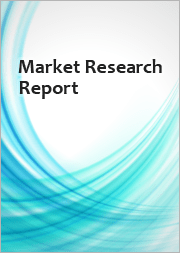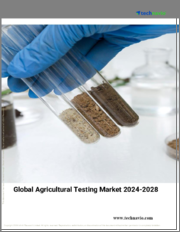
|
시장보고서
상품코드
1722925
농업 검사 시장 : 샘플·기술·용도, 지역별 시장 규모, 점유율, 동향, 예측(2025-2033년)Agricultural Testing Market Size, Share, Trends, and Forecast by Sample, Technology, Application, and Region, 2025-2033 |
||||||
세계 농업 검사 시장 규모는 2024년에 61억 1,000만 달러에 달할 것으로 예측됩니다. 향후 IMARC Group은 이 시장이 2033년까지 89억 1,000만 달러에 달하고, 2025-2033년 4.07%의 연평균 복합 성장률(CAGR)을 보일 것으로 예측했습니다. 현재 북미가 시장을 독점하고 있으며, 2024년에는 45.0% 이상의 큰 시장 점유율을 차지할 것으로 예측됩니다. 식품 안전, 규제 준수, 정밀 농업, 지속 가능한 농법에 대한 수요 증가가 이 시장을 주도하고 있습니다.
농업 검사는 물, 종자, 토양의 오염물질 함량과 품질을 측정하는 기술을 말합니다. 최적의 작물 수확을 촉진하기 위해 필요한 성분, 수분, 토양 비옥도, 산도, pH 수준 등 적절한 자원과 투입물을 분석하는 데 사용됩니다. 농업 검사에는 생물고형물, 비료, 종자, 토양, 물의 검사가 포함되며, 주로 비옥도를 특성화하고 관개용 분석 수질을 평가합니다. 이를 통해 농가, 지자체 및 환경 기관은 작물 생산, 품질, 수익성 및 전체 밭의 영양소 이용률을 향상시키기 위해 적절한 비료를 선택할 수 있습니다.
농업 검사 시장 동향 :
세계 농업 검사 시장의 성장을 가속하는 주요 요인 중 하나는 특히 신흥 경제권의 급속한 인구 증가, 도시화, 산업화에 따른 농산물 수요 증가입니다. 농업 검사는 성분의 품질을 유지하면서 유전자 조작을 통해 작물이 만들어지도록 보장합니다. 또한, 반응성 관절염, 암, 신장 및 간 질환, 뇌 및 신경 장애 등 다양한 식중독의 발생이 증가함에 따라 전 세계적으로 농업 검사의 채택을 촉진하고 있습니다. 또한 사물인터넷(IoT)과 인공지능(AI)의 통합 등 다양한 기술 발전으로 인해 원격지에 위치한 불충분한 농작물을 실시간으로 파악할 수 있게 되면서 시장 성장에 탄력을 받고 있습니다. 이와는 별도로, 광범위한 연구개발(R&D) 활동과 효과적인 샘플 테스트 및 농업 상용화를 위한 시설이 잘 갖춰진 연구소의 설립과 함께 시장에 대한 밝은 전망을 만들어내고 있습니다.
본 보고서에서 다룬 주요 질문
- 농업 검사 시장 규모는?
- 농업 검사 시장 전망은?
- 농업 검사 시장을 이끄는 주요 요인은?
- 농업 검사 시장에서 가장 큰 점유율을 차지하는 지역은?
- 세계 농업 검사 시장의 주요 기업은?
목차
제1장 서문
제2장 조사 범위와 조사 방법
- 조사 목적
- 이해관계자
- 데이터 소스
- 1차 정보
- 2차 정보
- 시장 추정
- 보텀업 접근
- 톱다운 접근
- 조사 방법
제3장 주요 요약
제4장 서론
- 개요
- 주요 업계 동향
제5장 세계의 농업 검사 시장
- 시장 개요
- 시장 실적
- COVID-19의 영향
- 시장 예측
제6장 시장 분석 : 샘플
- 물
- 토양
- 배정
- 바이오 솔리드
- 비료
- 기타
제7장 시장 분석 : 기술별
- 기존
- 급속형
- 기타
제8장 시장 분석 : 용도별
- 안전성 시험
- 품질 보증
- 기타
제9장 시장 분석 : 지역별
- 북미
- 미국
- 캐나다
- 아시아태평양
- 중국
- 일본
- 인도
- 한국
- 호주
- 인도네시아
- 기타
- 유럽
- 독일
- 프랑스
- 영국
- 이탈리아
- 스페인
- 러시아
- 기타
- 라틴아메리카
- 브라질
- 멕시코
- 기타
- 중동 및 아프리카
- 시장 내역 : 국가별
제10장 SWOT 분석
- 개요
- 강점
- 약점
- 기회
- 위협
제11장 밸류체인 분석
제12장 Porter의 Five Forces 분석
- 개요
- 바이어의 교섭력
- 공급 기업의 교섭력
- 경쟁 정도
- 신규 진출업체의 위협
- 대체품의 위협
제13장 가격 분석
제14장 경쟁 구도
- 시장 구조
- 주요 기업
- 주요 기업 개요
- Agilent Technologies Inc.
- ALS Limited
- bioMerieux SA
- Bureau Veritas SA
- Element Materials Technology
- Eurofins Scientific
- Intertek Group PLC
- Merck KGaA
- R J Hill Laboratories Limited
- Scientific Certification Systems Inc.
- SGS S.A.
- TUV Nord Group
The global agricultural testing market size was valued at USD 6.11 Billion in 2024. Looking forward, IMARC Group estimates the market to reach USD 8.91 Billion by 2033, exhibiting a CAGR of 4.07% during 2025-2033. North America currently dominates the market, holding a significant market share of over 45.0% in 2024. The market is driven by increasing demand for food safety, regulatory compliance, precision farming, and sustainable agricultural practices.
Agriculture testing refers to the technique of measuring contaminant content and quality of water, seed, and soil. It is used for analyzing suitable resources and inputs, such as composition, moisture, soil fertility, acidity, and pH level, required to facilitate optimum crop yield. Agriculture testing includes bio-solid, manure, seed, soil and water testing, which primarily characterizes the fertility level and evaluates analytical water quality for irrigation. This, in turn, is assisting farmers, municipalities, and environmental agencies in selecting suitable fertilizers for enhancing crop production, quality, profitability, and nutrient availability across a field.
Agricultural Testing Market Trends:
One of the key factors driving the global agriculture testing market growth is the increasing demand for agricultural products on account of rapid population expansion, urbanization, and industrialization, particularly in emerging economies. Agriculture testing ensures crops are made through genetic engineering, while maintaining the quality of ingredients. Additionally, the increasing outbreaks of various foodborne illnesses, including reactive arthritis, cancer, kidney and liver failure, and brain and neural disorders are facilitating the adoption of agriculture testing across the globe. Besides this, the increasing instances of improper disposal of untreated industrial wastes into the environment have prompted governments of various nations to perform periodical soil testing, which, in turn, is aiding in enhancing the safety and quality of agricultural commodities, Moreover, various technological advancements, such as the integration of the Internet of Things (IoT) and artificial intelligence (AI), to provide real-time insights into the remotely located, insufficiently treated fields are providing an impetus to the market growth. Apart from this, extensive research and development (R&D) activities, along with the establishment of well-equipped laboratories to effectively test samples and commercialize farming, are creating a positive outlook for the market.
Key Market Segmentation:
Breakup by Sample:
- Water
- Soil
- Seed
- Biosolids
- Manure
- Others
Breakup by Technology:
- Conventional
- Rapid
- Others
Breakup by Application:
- Safety Testing
- Quality Assurance
- Others
Breakup by Region:
- North America
- United States
- Canada
- Asia-Pacific
- China
- Japan
- India
- South Korea
- Australia
- Indonesia
- Others
- Europe
- Germany
- France
- United Kingdom
- Italy
- Spain
- Russia
- Others
- Latin America
- Brazil
- Mexico
- Others
- Middle East and Africa
Competitive Landscape:
The competitive landscape of the industry has also been examined along with the profiles of the key players being Agilent Technologies Inc., ALS Limited, bioMerieux SA, Bureau Veritas SA, Element Materials Technology, Eurofins Scientific, Intertek Group PLC, Merck KGaA, R J Hill Laboratories Limited, Scientific Certification Systems Inc., SGS S.A. and TUV Nord Group.
Key Questions Answered in This Report
- 1.How big is the agricultural testing market?
- 2.What is the future outlook of the agricultural testing market?
- 3.What are the key factors driving the agricultural testing market?
- 4.Which region accounts for the largest agricultural testing market share?
- 5.Which are the leading companies in the global agricultural testing market?
Table of Contents
1 Preface
2 Scope and Methodology
- 2.1 Objectives of the Study
- 2.2 Stakeholders
- 2.3 Data Sources
- 2.3.1 Primary Sources
- 2.3.2 Secondary Sources
- 2.4 Market Estimation
- 2.4.1 Bottom-Up Approach
- 2.4.2 Top-Down Approach
- 2.5 Forecasting Methodology
3 Executive Summary
4 Introduction
- 4.1 Overview
- 4.2 Key Industry Trends
5 Global Agricultural Testing Market
- 5.1 Market Overview
- 5.2 Market Performance
- 5.3 Impact of COVID-19
- 5.4 Market Forecast
6 Market Breakup by Sample
- 6.1 Water
- 6.1.1 Market Trends
- 6.1.2 Market Forecast
- 6.2 Soil
- 6.2.1 Market Trends
- 6.2.2 Market Forecast
- 6.3 Seed
- 6.3.1 Market Trends
- 6.3.2 Market Forecast
- 6.4 Biosolids
- 6.4.1 Market Trends
- 6.4.2 Market Forecast
- 6.5 Manure
- 6.5.1 Market Trends
- 6.5.2 Market Forecast
- 6.6 Others
- 6.6.1 Market Trends
- 6.6.2 Market Forecast
7 Market Breakup by Technology
- 7.1 Conventional
- 7.1.1 Market Trends
- 7.1.2 Market Forecast
- 7.2 Rapid
- 7.2.1 Market Trends
- 7.2.2 Market Forecast
- 7.3 Others
- 7.3.1 Market Trends
- 7.3.2 Market Forecast
8 Market Breakup by Application
- 8.1 Safety Testing
- 8.1.1 Market Trends
- 8.1.2 Market Forecast
- 8.2 Quality Assurance
- 8.2.1 Market Trends
- 8.2.2 Market Forecast
- 8.3 Others
- 8.3.1 Market Trends
- 8.3.2 Market Forecast
9 Market Breakup by Region
- 9.1 North America
- 9.1.1 United States
- 9.1.1.1 Market Trends
- 9.1.1.2 Market Forecast
- 9.1.2 Canada
- 9.1.2.1 Market Trends
- 9.1.2.2 Market Forecast
- 9.1.1 United States
- 9.2 Asia-Pacific
- 9.2.1 China
- 9.2.1.1 Market Trends
- 9.2.1.2 Market Forecast
- 9.2.2 Japan
- 9.2.2.1 Market Trends
- 9.2.2.2 Market Forecast
- 9.2.3 India
- 9.2.3.1 Market Trends
- 9.2.3.2 Market Forecast
- 9.2.4 South Korea
- 9.2.4.1 Market Trends
- 9.2.4.2 Market Forecast
- 9.2.5 Australia
- 9.2.5.1 Market Trends
- 9.2.5.2 Market Forecast
- 9.2.6 Indonesia
- 9.2.6.1 Market Trends
- 9.2.6.2 Market Forecast
- 9.2.7 Others
- 9.2.7.1 Market Trends
- 9.2.7.2 Market Forecast
- 9.2.1 China
- 9.3 Europe
- 9.3.1 Germany
- 9.3.1.1 Market Trends
- 9.3.1.2 Market Forecast
- 9.3.2 France
- 9.3.2.1 Market Trends
- 9.3.2.2 Market Forecast
- 9.3.3 United Kingdom
- 9.3.3.1 Market Trends
- 9.3.3.2 Market Forecast
- 9.3.4 Italy
- 9.3.4.1 Market Trends
- 9.3.4.2 Market Forecast
- 9.3.5 Spain
- 9.3.5.1 Market Trends
- 9.3.5.2 Market Forecast
- 9.3.6 Russia
- 9.3.6.1 Market Trends
- 9.3.6.2 Market Forecast
- 9.3.7 Others
- 9.3.7.1 Market Trends
- 9.3.7.2 Market Forecast
- 9.3.1 Germany
- 9.4 Latin America
- 9.4.1 Brazil
- 9.4.1.1 Market Trends
- 9.4.1.2 Market Forecast
- 9.4.2 Mexico
- 9.4.2.1 Market Trends
- 9.4.2.2 Market Forecast
- 9.4.3 Others
- 9.4.3.1 Market Trends
- 9.4.3.2 Market Forecast
- 9.4.1 Brazil
- 9.5 Middle East and Africa
- 9.5.1 Market Trends
- 9.5.2 Market Breakup by Country
- 9.5.3 Market Forecast
10 SWOT Analysis
- 10.1 Overview
- 10.2 Strengths
- 10.3 Weaknesses
- 10.4 Opportunities
- 10.5 Threats
11 Value Chain Analysis
12 Porters Five Forces Analysis
- 12.1 Overview
- 12.2 Bargaining Power of Buyers
- 12.3 Bargaining Power of Suppliers
- 12.4 Degree of Competition
- 12.5 Threat of New Entrants
- 12.6 Threat of Substitutes
13 Price Analysis
14 Competitive Landscape
- 14.1 Market Structure
- 14.2 Key Players
- 14.3 Profiles of Key Players
- 14.3.1 Agilent Technologies Inc.
- 14.3.1.1 Company Overview
- 14.3.1.2 Product Portfolio
- 14.3.1.3 Financials
- 14.3.1.4 SWOT Analysis
- 14.3.2 ALS Limited
- 14.3.2.1 Company Overview
- 14.3.2.2 Product Portfolio
- 14.3.2.3 Financials
- 14.3.2.4 SWOT Analysis
- 14.3.3 bioMerieux SA
- 14.3.3.1 Company Overview
- 14.3.3.2 Product Portfolio
- 14.3.3.3 Financials
- 14.3.3.4 SWOT Analysis
- 14.3.4 Bureau Veritas SA
- 14.3.4.1 Company Overview
- 14.3.4.2 Product Portfolio
- 14.3.4.3 Financials
- 14.3.4.4 SWOT Analysis
- 14.3.5 Element Materials Technology
- 14.3.5.1 Company Overview
- 14.3.5.2 Product Portfolio
- 14.3.6 Eurofins Scientific
- 14.3.6.1 Company Overview
- 14.3.6.2 Product Portfolio
- 14.3.6.3 Financials
- 14.3.6.4 SWOT Analysis
- 14.3.7 Intertek Group PLC
- 14.3.7.1 Company Overview
- 14.3.7.2 Product Portfolio
- 14.3.7.3 Financials
- 14.3.7.4 SWOT Analysis
- 14.3.8 Merck KGaA
- 14.3.8.1 Company Overview
- 14.3.8.2 Product Portfolio
- 14.3.8.3 Financials
- 14.3.8.4 SWOT Analysis
- 14.3.9 R J Hill Laboratories Limited
- 14.3.9.1 Company Overview
- 14.3.9.2 Product Portfolio
- 14.3.10 Scientific Certification Systems Inc.
- 14.3.10.1 Company Overview
- 14.3.10.2 Product Portfolio
- 14.3.11 SGS S.A.
- 14.3.11.1 Company Overview
- 14.3.11.2 Product Portfolio
- 14.3.11.3 Financials
- 14.3.12 TUV Nord Group
- 14.3.12.1 Company Overview
- 14.3.12.2 Product Portfolio
- 14.3.12.3 SWOT Analysis
- 14.3.1 Agilent Technologies Inc.



















